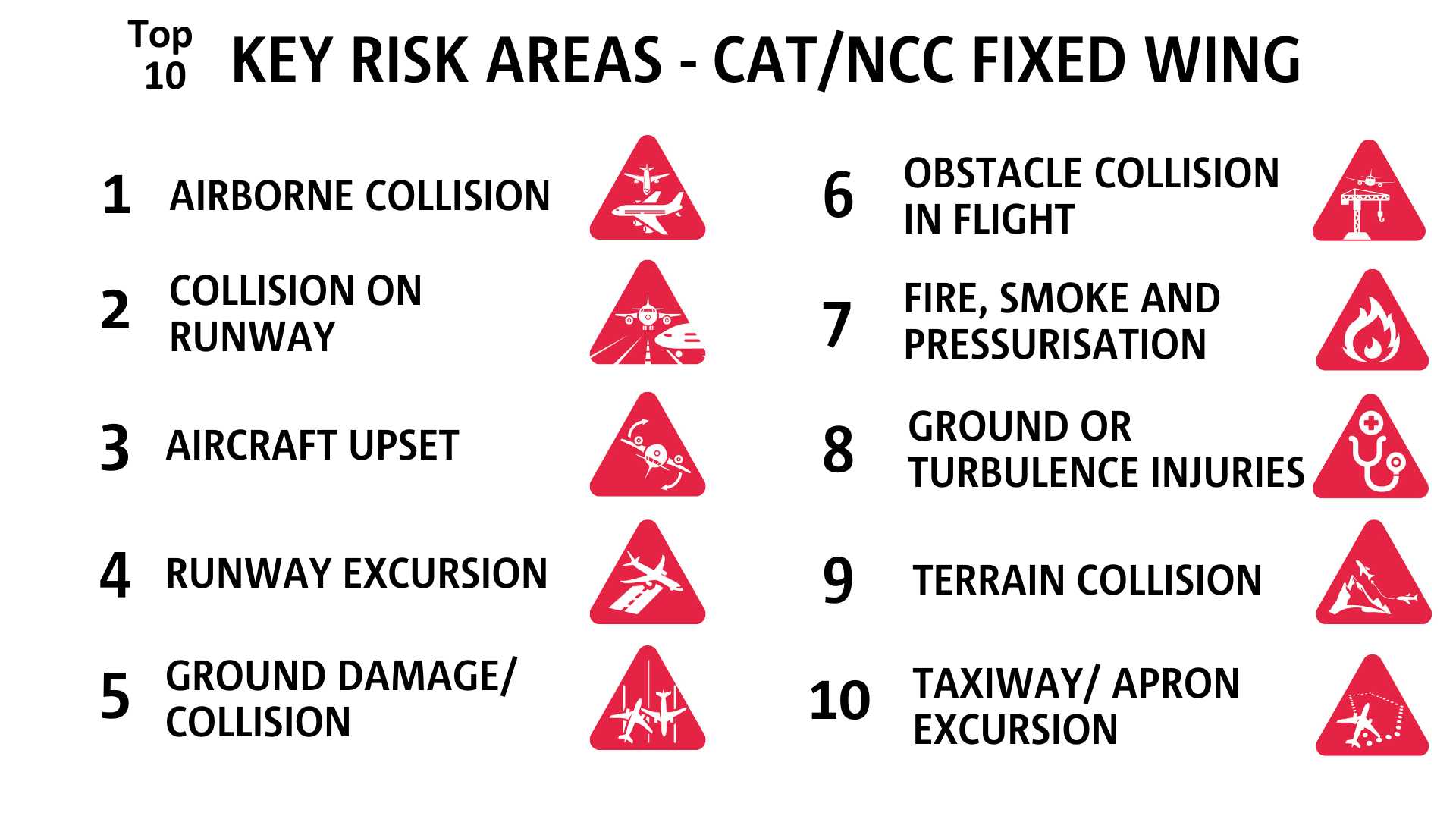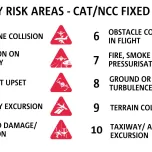If we want to prevent accidents from happening, we first need to be sure what type of accidents we are talking about. In this short article we outline the top Key Risk Areas (KRAs) as we call them in the ECCAIRS taxonomy for aeroplanes involved in Commercial Air Transport (CAT) and Non-Complex Commercial (NCC) operations.
The Top 10 Key Risk Areas
In the visual below you can see the Top 10 Key Risk Areas. Think about them as the accident outcomes that our safety efforts are trying to prevent from happening.
They are prioritised based on the European Risk Classification Scheme (ERCS) score in the analysis from EASA in the Annual Safety Review. You can download this visual as a JPG or PDF at the bottom of the article to use in your own material and presentations.

Some more explanation of each Key Risk Area:
Likely you know about these different Key Risk Areas but it worth providing a little more explanation so it's clear what we are talking about.
Airborne Collision
Airborne collisions are collisions between aircraft where both (all) aircraft were airborne. Drone collisions are also included in this KRA. It can be a particular challenge in areas around smaller airports where General Aviation aircraft can mix with passenger aircraft.
Collision on Runway
This is a collision between an aircraft and another object (other aircraft, vehicles, etc.) or person that occurs on a runway of an aerodrome or other predesignated landing area. It does not include collisions with birds or wildlife. The recent accident in Tokyo highlighted the challenges with preventing this type of accident.
Aircraft Upset
an undesired aircraft state characterized by unintentional divergences from parameters normally experienced during operations, which might ultimately lead to an uncontrolled impact with terrain.
Runway Excursion
An occurrence when an aircraft leaves the runway of an aerodrome or landing surface of any other predesignated landing area, without getting airborne.
Ground Damage/ Collision
Damage to aircraft caused by operation of aircraft on ground on any other ground area than a runway or predesignated landing area. It also includes damage when the aircraft is stationary during ground handling or maintenance.
Obstacle Collision in Flight
A collision between an airborne aircraft and obstacles rising from the surface of the earth. For example, such obstacles include tall buildings, trees, power cables, telegraph wires, and antennae as well as tethered objects.
Fire, Smoke and Pressurisation
An occurrence involving cases of fire, smoke, fumes, or pressurization situations that may become incompatible with human life. This includes occurrences involving fire, smoke, or fumes affecting any part of an aircraft, in-flight or on the ground, which is not the result of impact or malicious acts.
Ground or Turbulence Injuries
An occurrence where fatal or non-fatal injuries have been inflicted, which cannot be attributed to any other key risk area such as ground injuries or those occurring in turbulence.
Terrain Collision (CFIT)
An occurrence where an airborne aircraft collides with terrain, without indication that the flight crew was unable to control the aircraft. Thankfully with the adopted of Ground Proximity Warning Systems, this accident outcome is much less common in modern aviation.
Taxiway or Apron Excursion
An occurrence when an aircraft leaves the apron or movement area of an aerodrome, not the runway.

Dear John,
Is it possible that you will publish the top key risk areas for helicopter operations in the lower airspace, especially HEMS?
Regards
Peter Eklund
Hey Peter, there was a similar article some time ago. It’s called „The 10 Biggest Threats for Air Ambulance Helicopters“. You should find it easily. Regards
Hi Henry, I'm not sure that is exactly the same. This top 10 key risk area are ranked based on the ERCS, while the 10 biggest threats for HEMS were (I supposed) generically ranked on accidents statistics. Would be great if John could confirm that.
I suspect the ERCS analysis for helicopter flight may produce some surprise.
Hi All, we did a mini version of this covering all the different helicopter operation types in the summary of the Annual Safety Review 2023. You can find this on the link here: https://www.easa.europa.eu/community/topics/easa-annual-safety-review-h…
We have the full analysis in the Annual Safety Review covering each of the domains with graphs of all the Key Risk Areas.
Please log in or sign up to comment.